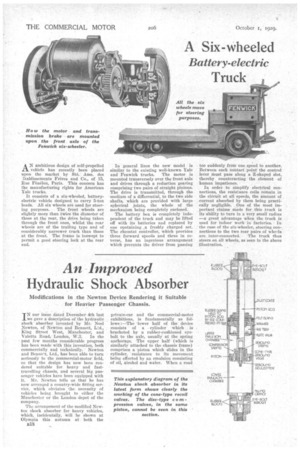An Improved Hydraulic Shock Absorber
Page 52

Page 53

If you've noticed an error in this article please click here to report it so we can fix it.
Modifications in the Newton Device Rendering it Suitable for Heavier Passenger Chassis.
TN our issue dated December .4th last
we gave a description of the hydraulic shock absorber invented, by Mr: Noel Newton, of -Newton and Bennett, Ltd., King Street West, Manchester, and
Valetta Road, London, W.3. In the
• past few months considerable progress has been madewith this invention, both commercially and technically. Newton and Bennet, Ltd., has been able to turn seriously to the commercial-motor field, so that the design has now been rendered suitable for heavy and fast travelling chassis, and several big passenger vehicles have been equippedwith
it. Mr. Newton tells us that he has now arranged a country-wide fitting service, which obviates the, necessity of vehicles being brought to either the Manchester or the London depot of the company.
The arrangement of the modified Newton shock absorber for heavy vehicles, which, incidentally, will be shown at Olympia this autumn at both the
B1.8
private-car and the commercial-motor exhibitions, is fundamentally as follows :—The -lower half of the device consists of a cylinder which is bracketed by a rubber-cushioned eyebolt to the axle, usually. at the spring anchorage. The upper halt (which is similarly attached to the chassis frame) comprises a piston which slides in the cylinder, resistance to its movement beiitg effected by an emulsion consisting of oil, alcohol and water. When a road
shock causes the piston to descend in the cylinder, emulsion forces its way upward through four holes in the pistonhead assembly against a spring which offers a I0-lb. resistance. This means that in practice an almost free upward flow is permitted, for so soon as the 10-1h. resistance is overcome no further resistance is encountered.
Upon the return stroke the emulsion is forced against two conical valves, also held by the resistance of a 10-lb. volute spring. It will be seen that the rate of flow of the emulsion in this ease will increase directly with the degree to which the cones are depressed, but the further the cones are depressed the greater becomes their resistance, as the spring offers increasing resistance under compression. Progressive 'reaction is thus afforded, which effectively damps the rebound of toe road springs.
The pressure of the cones in their seatings can be set by the adjustment of tension upon the spring which holds them closed, this being varied to suit the vehicle towhich the shock absorbers are fitted.
The lower cylinder is sealed at the top by a gland fitting closely around the piston rod, and, to provide for displacement caused by the piston rod entering the lower cylinder, a small air chamber is introduced. The air is naturally compressed when the piston descends, and its pressure would, on the rebound stroke, cause the cone valves to open too quickly, reducing their effectiveness. To prevent this the compressed air is trapped above a hanging plate valve, and the pressure is released too slowly to spoil the progressive action of the cone valves. Incidentally, the compression of air in the trap serves the useful purpose of pressing the rubber gland tightly around the piston rod, thus preventing the escape of emulsion at this point.
The most important development -which Mr. Newton has made in the past year is undoubtedly the discovery of an emulsion that is freefrom disadvantages which attend the use of oil. First, it does not become oxidized when in contact with the air (oil is converted into a paste by oxidation) ; secondly, the consistency does not vary with the temperature; thirdly, whereas oil has powerful capillary properties which cause it to creep through the most carefully designed glands, the new 'emulsion is quite free from this defect. In fact, it seems to have a tendency to "stand away" from the metal parts with which it is in contact, and when the shock absorber is emptied the emulsion pours completely out to the last drop, leaving the container quite clean. It is a cleanly liquid to handle.
By reason of its shape and of the simple eye-bolt bracket which can be employed to attach each end of the shock absorber to the frame and axle of the chassis, thick blocks of rubber providing a universal joint in the attachment of the eye-bolt to the absorber, the necessity of turning ball joints or bearings of any other description is completely dispensed with. Thus, the Newton shock absorber is dead silent in action, neat and simple in fitting and appearance, and it calls for the minimum of attention, requiring extra emulsion approximately once a year.






















































































































